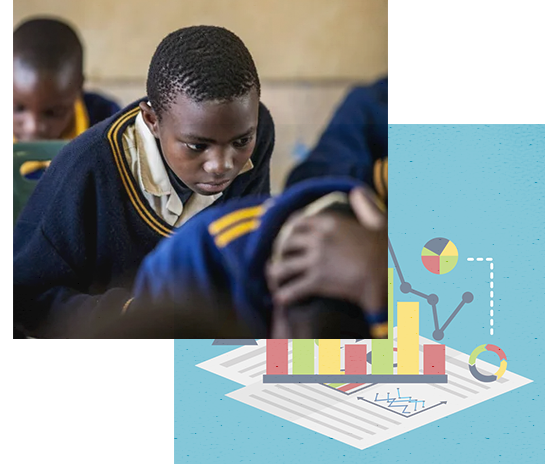Responsible for educational research & reporting on educational services

Our Vision
Our Mission

The EMIS department in the Ministry of Education and Training is responsible for the promotion and use of information in the education sector to inform on policy planning and implementation, decision making, monitoring and evaluation. The acronym EMIS stands for “Education Management Information System”. It is a system for organizing information based on a systematic way for the management of educational development. It is an information centre in the Ministry and is responsible for educational research; data (collection, processing, analyzing), report (writing, publication, dissemination) and reporting on educational services.
The unit does undertake research especially with regards to finding out about the status and/or health of the education system. It a management tool, as the saying goes, “One cannot measure or monitor something that cannot be measured”, and the tool for measurement in education sector is the EMIS. This is through admistrative census or survey questionnaires that are sent to schools through the REOs. The aim of the information collected at ALL schools and institutions in country is to inform on the progress made by the Ministry and the country on the programs, projects undertaken by the Ministry and partners in the education sector space.
In June 2020, the Ministry of Education and Training (MoET) Eswatini, with funding support from UNICEF Eswatini, initiated the development of an electronic education management information system (EMIS) to improve the reporting, management, and analysis of education data in Eswatini. The new digitized EMIS was customized on the DHIS2 platform with technical support from the University of Oslo, HISP Uganda, and HISP Mozambique. Capacity building trainings were conducted for; 1) the MoET central level EMIS team to ably maintain and support the use of the system; 2) the regional level EMIS staff on how to capture, validate, analyze, and use EMIS data; and 3) the school administrators on the new data collection tools, data capture, validation, and analysis.
Following the capacity building training, the new data collection tools and system were tested in selected schools and feedback informed the update of the system and data collection tools. In November 2021, a pilot of the new EMIS was initiated in 100 schools in Manzini. Aggregate and individual-level data for both learners and teachers were collected and captured into the DHIS2-EMIS by data capturers at a regional level. An assessment of the pilot implementation conducted in May 2022 revealed buy-in and ownership of the DHIS2-EMIS by stakeholders at the MoET, education partners, civil society regional and school levels.
Currently, EMIS utilizes the web based system to collect , analyse and report on the schools information in the country whilst also managing individual learner and Staff information using their Perssonal Identification Number (PIN) to keep and maintain their profiles in the system. The use of PIN in the system is to ensure that the Ministry keeps tracks on the progress of Learners in the schools system and also develop relevant and effective programes that will ensure accessibility, retention and completion of all EmaSwati children in schools. The Ministry also will have relevent data on teachers in the country to inform on their profiles, qualifications, training , subject teaching etc. and this will in turn assist in Human Reasource Management by the Ministry. The Free Primary Education Programe and OVC programe will aslo benefit the Ministry and schools in management, disbursent and monitoring of the beneficiaries on a timely basis.
The unit is also working with Higher education/TVET and Non formal Education to ensure that the use of PIN to track learners is done on all level , such that there will be systems intropability with other Ministry such Health, Home Affairs and Labour.
Background
All statistics of formal, and non-formal, from early childhood, to higher education, teacher training institutions and technical and vocational institutions all are under the responsibility of unit. The education institutions are the major source of educational information. The role of the regions is to create close contact with institutions and coordinate the process at grassroots level. The other role of the district staff is to relay information, guidelines, and reports from the centre to institutions and back.
Finally the central EMIS plays a coordinating role, connect major stakeholders in partnership and experience sharing program while at the same time responsible for the following activities:
- Monitoring of the Ministry goals, visions and strategies. This includes monitoring and evaluation of all activities in education in the National , Regional and also international agendas.
- Educational Research and Survey administration of the Ministry of Education and Training including quantitative instrument design, testing, re-design, distribution and collection, organizing and processing, compilation and cleaning of data ; Analysis, interpretation and use of educational information.
- Assisting in the development of research agenda for the Ministry which includes policy and analysis of the state of education thus improving the MOE performance and transparency standards.
- Advising the Ministry on policy directions, deriving policies, from simulations/ forecasts/ and projections.
- Educational statistics on the whole sector (formal and non-formal) sector.
- The unit is also in charge of the Ministry’s simulation models which include the “Financial Operational Costs Models” at primary and secondary levels. This requires annual updates and will be used for evidence based budgeting.
- The monitoring and evaluation (analysis) of the HIV and AIDS situation especially at primary and secondary education levels.
- Reports on educational statistics to international agencies which include the UNESCO Institute for Statistics, the SADC and AU This involves consolidating all data needs and also mounting surveys for all additional indicators that may be needed.
- Coordinate activities of the South and East African Consortium for Monitoring Educational Quality (SACMEQ) in the country.
